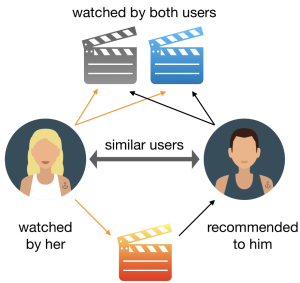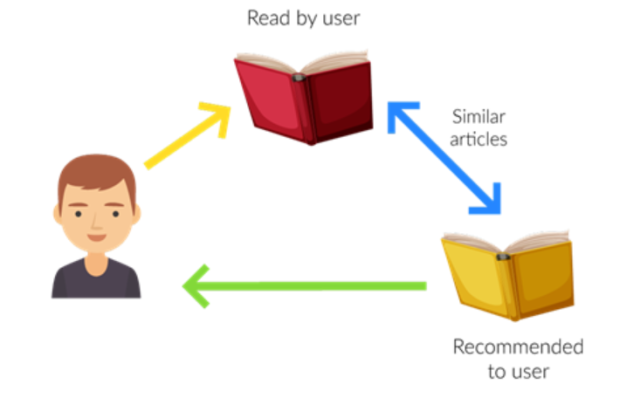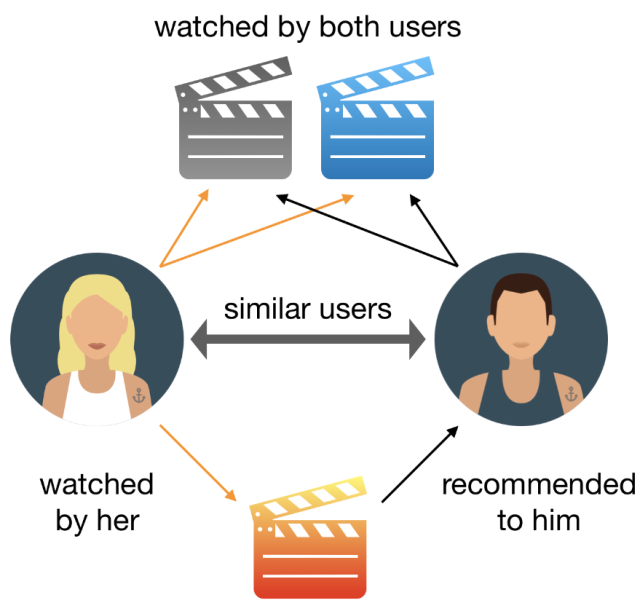
Last updated: 16th Sep, 2024
Recommender systems are widely used in applications such as personalized content recommendation (e.g., movies, books, music), online shopping, and social media. One common example of a recommender system is Netflix. Netflix uses a sophisticated recommender system to suggest movies and TV shows that a user may want to watch. The recommendation algorithm takes into account past user behavior, such as ratings, viewing history, and interactions with content (e.g., likes, watch time).
Recommender systems typically leverage techniques such as collaborative filtering, content-based filtering, or hybrid methods that combine both approaches. These systems analyze patterns in user behavior, item attributes, and sometimes additional context, such as demographics or social network data, to provide tailored suggestions and improve user experience.
In this blog post, you will learn about recommender systems and some of the different types of recommender systems with the help of examples.
What is a Recommender System? What are the benefits?
A recommender system are systems that recommend products or services to customers. Amazon’s recommender system reportedly drives 35% of its sales (2020 data). Recommender systems get utilized in a variety of areas, with commonly recognized examples taking the form of playlist generators for video and music services, product recommenders for online stores, etc.
Recommender systems often leverage machine learning (ML) algorithms in order to make better predictions about a user’s preferences. These ML algorithms has its own strengths and weaknesses, and the best algorithm for a particular application will depend on the nature of the data. The following are some of the ML algorithms that are used in recommender systems:
- K-NearestNeighbor (K-NN) for Collaborative Filtering: The key idea behind using K-NN in recommender systems is to find the nearest neighbors (similar users or items) based on historical data and use their preferences or interactions to make recommendations.
- In user-based collaborative filtering, K-NN can be used to find the k most similar users to a target user based on their historical interactions with items. The similarity can be measured using various distance metrics, such as cosine similarity. Recall that the cosine similarity is a mathematical means for computing the similarity between pairs of vectors (or rows of numbers treated as vectors). Once the similar users are identified, the system can recommend items that these users have liked or interacted with.
- In item-based collaborative filtering, K-NN can be used to find the k most similar items to a target item based on user preferences. As like user-based collaborative filtering, the similarity can be calculated using techniques like cosine similarity or adjusted cosine similarity. Once similar items are identified, the system can recommend these items to users who have shown interest in the target item. It’s worth noting that K-NN has some limitations, such as scalability issues with large datasets and the sparsity problem (when there are few overlapping interactions between users or items).
- Bayesian inference for Collaborative Filtering: Bayesian inference can be used in building recommender systems, particularly in the context of probabilistic graphical models. Bayesian inference allows for the incorporation of prior knowledge and uncertainty into the recommendation process. One approach that utilizes Bayesian inference is Bayesian Personalized Ranking (BPR). BPR is a popular method for collaborative filtering in recommender systems. It is based on pairwise ranking and uses Bayesian principles to model the preferences of users. In BPR, a probabilistic model is constructed to estimate the likelihood of a user’s preference for one item over another. The model incorporates prior knowledge about user-item interactions and learns the parameters that maximize the likelihood of observed rankings. The Bayesian framework enables the system to update its beliefs about user preferences as more data is observed.
- Dimensionality reduction: Dimensionality reduction techniques are commonly used in building recommender systems to address the “curse of dimensionality” and improve the efficiency and performance of the recommendation process. These techniques aim to reduce the number of dimensions or features in the data while preserving important information or structure. There are two main ways dimensionality reduction is used in recommender systems.
- Matrix factorization: Matrix factorization is a dimensionality reduction technique widely used in collaborative filtering-based recommender systems. It aims to decompose the user-item interaction matrix into lower-dimensional representations or latent factors. The idea is to represent users and items in a shared latent space where their preferences and characteristics are captured. This reduces the dimensionality of the original data and allows for efficient computation of recommendations.
- Feature extraction: In content-based filtering approaches, dimensionality reduction techniques can be used to extract meaningful features from item attributes or content. For example, in text-based recommender systems, techniques like Latent Semantic Analysis (LSA) or Latent Dirichlet Allocation (LDA) can be used to reduce the dimensionality of the text data and extract latent topics or features.
The following is a list of benefits / value of building recommender system and why businesses must consider:
- Recommender systems help businesses make money by increasing sales and predicting what customers want.
- Recommender systems can improve customer satisfaction by providing relevant recommendations. They can improve customer loyalty by suggesting new items that the customer may like.
- Recommender systems can reduce the amount of time it takes to find the right item for a customer.
- Recommender systems can help businesses learn more about their customers’ preferences.
Types of Recommender Systems
There are a number of different types of recommender systems. Some of them are listed below:
- Content-based recommendation
- Collaborative filtering based recommendation
- Hybrid recommender system
Content based recommender system
The most common type of recommender system is the content-based recommender system. A content-based recommender system is a type of recommender system that relies on the similarity between items to make recommendations. For example, if you’re looking for a new movie to watch, a content-based recommender system might recommend movies that are similar to ones you’ve watched in the past. The picture below represents content-based filtering recommender system:
Content-based recommender systems are commonly used in music, books, and movies. They can be used to recommend products, services, or even websites. Content-based recommender systems are based on the idea that if you like one item, you’re likely to like other items that are similar to it.
To build a content-based recommender system, you need to first define what similarity means. This is where machine learning comes in. Content-based recommenders require two ingredients: a way to vectorize – convert to numbers – the attributes that characterize a service or product, and a means for calculating similarity between the resulting vectors. The first one can be achived by using using classes such as sklearn CountVectorizer to converts text into tables of word counts. For similarity, one of the simplest and most effective ways is a technique called cosine similarity. Cosine similarity isn’t limited to two dimensions; it works in higher-dimensional space as well. To help compute cosine similarities regardless of the number of dimensions, Scikit offers the cosine similarity function.
Collaborative filtering recommender system
Another type of recommender system is the collaborative filtering recommender system. A collaborative filtering recommender system is a type of machine learning algorithm that makes predictions about what a user might want to buy or watch based on the past behavior of other users. The algorithm looks at the items that other users with similar taste have purchased or rated highly, and recommends those items to the new user. The picture below represents collaborative-filtering recommender system:
The main advantage of collaborative filtering is that it doesn’t require any information about the users or items; all it needs is a dataset of past user behavior. Collaborative filtering is one of the most popular techniques for building recommender systems, and is used by major companies such as Amazon, Netflix, and Spotify.
Hybrid recommender system
A third type of recommender system is the hybrid recommender system. The hybrid approach has become increasingly popular in recent years as it offers the potential to overcome some of the limitations of each individual approach.
Content-based recommender systems focus on the attributes of items in order to make recommendations. This can often lead to issues with scalability, as the system needs to be constantly updated with new content in order to make accurate recommendations. Collaborative filtering systems, on the other hand, focus on the relationships between users and items. This can often result in problems with sparsity, as it can be difficult to find enough users who have rated a given item. The hybrid approach seeks to overcome these limitations by combining the two approaches.
A hybrid recommender system is a type of recommender system that combines both content-based and collaborative filtering approaches. The hybrid approach takes advantage of both content-based and collaborative filtering by using them to supplement each other. For example, a hybrid recommender system might first identify a set of items that are similar to the item the user is interested in, and then use collaborative filtering to identify which of those items the user is most likely to enjoy. This approach can provide more accurate recommendations than either method used alone. The hybrid approach has been shown to be more effective than either method used alone, as it is able to leverage the strengths of both approaches. Hybrid recommender systems are often more scalable and efficient than pure content-based or collaborative filtering systems.
Examples of Recommender Systems
Some of the most popular examples of recommender systems include the ones used by Amazon, Netflix, and Spotify.
- Amazon’s recommender system is based on a combination of collaborative filtering and content-based algorithms. It uses past customer behavior to make recommendations for new products. Amazon’s recommender system is one of the most complex and sophisticated in the world.
- Netflix’s recommender system is also based on a combination of collaborative filtering and content-based algorithms. However, Netflix takes things a step further by also incorporating machine learning into its algorithm. This allows Netflix to make predictions about what a user might want to watch based on the behavior of other users.
- Spotify’s recommender system is based on collaborative filtering. It uses past user behavior to make recommendations for new songs to listen to.
Conclusion
Recommender systems are a type of machine learning based systems that are used to predict the ratings or preferences of items for a given user. There are three main types of Recommender Systems: collaborative filtering, content-based, and hybrid. Some of the most popular examples of Recommender Systems include the ones used by Amazon, Netflix, and Spotify. Collaborative filtering systems use past user behavior to make recommendations for new products. Content-based systems focus on the attributes of items in order to make recommendations. The hybrid approach is a combination of both content-based and collaborative filtering approaches. Hybrid recommender systems are often more scalable and efficient than pure content-based or collaborative filtering systems. If you would like to learn more about Recommender Systems, there are many resources available online. Please let us know if you have any questions. Thank you for reading!
- Mathematics Topics for Machine Learning Beginners - July 6, 2025
- Questions to Ask When Thinking Like a Product Leader - July 3, 2025
- Three Approaches to Creating AI Agents: Code Examples - June 27, 2025


It was nice explanation. But can you list down problems which are faced by recommendation systems now these days?
thanks